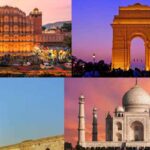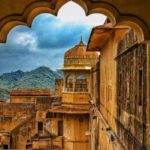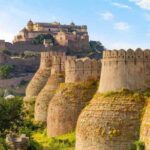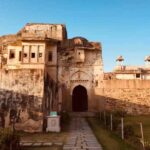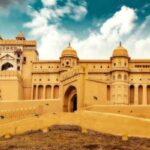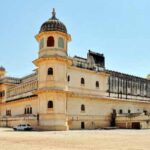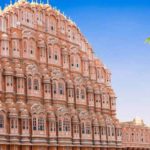Top 10 Famous Historical Places in Rajasthan, known as the “Land of Kings,” is a treasure trove of historical marvels that narrate tales of valor, grandeur, and cultural richness. This northwestern state of India boasts a myriad of historical sites, each with its own unique story.
One of the most iconic landmarks is the Amber Fort in Jaipur, a majestic hilltop fortress constructed in the 16th century. Its intricate architecture, including the Sheesh Mahal (Mirror Palace), showcases the opulence of the Rajput era. Jaipur also houses the City Palace, a magnificent blend of Mughal and Rajput architectural styles, and the Jantar Mantar, an ancient astronomical observatory.
In Jodhpur, the Mehrangarh Fort stands tall as a symbol of Rathore royalty. Its imposing walls guard palaces with ornate courtyards and museums filled with artifacts narrating centuries of history. The blue-painted houses surrounding the fort add to the city’s charm.
Udaipur, often hailed as the “Venice of the East,” boasts the City Palace Complex. Set on the banks of Lake Pichola, it is a series of palaces, courtyards, and gardens with breathtaking views of the lake and surrounding hills.
Jaisalmer, the “Golden City,” showcases the stunning Jaisalmer Fort, a UNESCO World Heritage Site. This living fort is home to numerous havelis (ornate residences) and temples, and it glows golden in the sunlight, giving it an ethereal aura.
Rajasthan’s historical legacy is further enriched by sites like Chittorgarh Fort, known for its heroic tales; Kumbhalgarh Fort with the world’s second-longest continuous wall; and the ancient city of Pushkar, famous for its sacred lake and Brahma Temple.
Exploring these historical marvels offers a glimpse into the opulent past of Rajasthan, leaving visitors awestruck by the grandeur and heritage of this vibrant state Rajasthan Budget Tours.
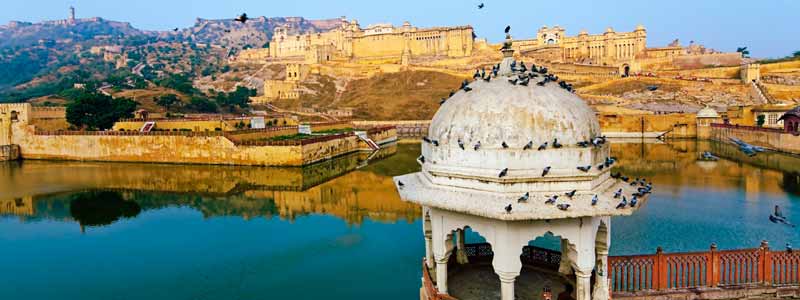
Amber Fort, Jaipur:
The Amber Fort, situated in the picturesque city of Jaipur, Rajasthan, is a resplendent testament to the grandeur and opulence of India’s historical past. This magnificent fort, also known as Amer Fort, stands proudly atop a rugged hill overlooking the Maota Lake, creating a striking reflection that adds to its charm.
Constructed in the 16th century by Raja Man Singh I, the fort represents a seamless fusion of Rajput and Mughal architectural styles. Its imposing walls, constructed from red sandstone and marble, exude a sense of strength and permanence. The fort’s artistic brilliance is most evident in the Sheesh Mahal, or the “Hall of Mirrors.” This dazzling chamber is adorned with thousands of tiny mirrors that reflect light in a mesmerizing dance, creating an ethereal ambiance.
The fort’s intricate design extends to its palaces, courtyards, and temples. The Diwan-e-Khas (Hall of Private Audience) and Diwan-e-Aam (Hall of Public Audience) stand as eloquent witnesses to the royal court’s ceremonial proceedings. The Sukh Niwas (Hall of Pleasure) is an ingenious example of ancient air conditioning, where cool water flowed through channels, creating a refreshing breeze.
The Amber Fort also houses the Ganesh Pol, an ornate gateway dedicated to the elephant-headed god, and the Shila Devi Temple, dedicated to the goddess Kali. The temple’s silver doors are an exquisite sight.
A visit to the Amber Fort is not only a journey through history but also an immersion into the artistic and architectural brilliance of the Rajput dynasty. The fort’s commanding presence and its breathtaking views of the surrounding landscape make it a must-visit destination for history enthusiasts and admirers of architectural splendor alike.
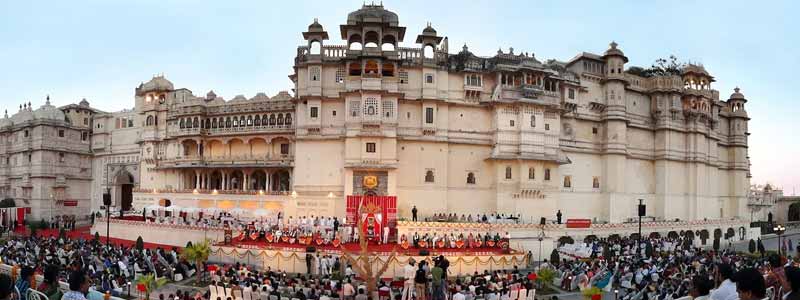
City Palace, Udaipur:
The City Palace in Udaipur, Rajasthan, stands as a magnificent testament to the opulence and grandeur of the Mewar dynasty. Perched on the banks of Lake Pichola, this sprawling complex is a harmonious blend of Rajasthani and Mughal architectural styles, offering a captivating glimpse into the history and culture of Udaipur.
Built over nearly four centuries, the palace is a living museum that showcases the artistic prowess of successive rulers. Its intricate facades, adorned with ornate balconies, jharokhas (overhanging enclosed balconies), and delicately carved archways, are a visual feast for visitors. The vibrant hues of the palace walls, reflecting in the placid waters of Lake Pichola, create an ethereal panorama.
The palace complex is divided into several courtyards, each with its unique features and historical significance. The Mor Chowk, or Peacock Courtyard, is adorned with exquisite mosaics of peacocks, while the Manak Mahal, or Ruby Palace, is resplendent with a captivating collection of crystal and porcelain.
The Zenana Mahal, or Women’s Palace, is a fascinating part of the complex, featuring intricately designed chambers that once housed the royal ladies. The Sheesh Mahal, or Palace of Mirrors, is another gem within the palace, where walls and ceilings are adorned with thousands of tiny reflective pieces, creating a glittering spectacle.
Visitors can also explore the Fateprakash Palace, which has been converted into a luxury heritage hotel, and the Crystal Gallery, showcasing a dazzling array of crystal artifacts.
The City Palace is not merely a historical relic; it is a living testament to the enduring legacy of the Mewar dynasty and a must-visit for anyone seeking to immerse themselves in the rich cultural tapestry of Udaipur.
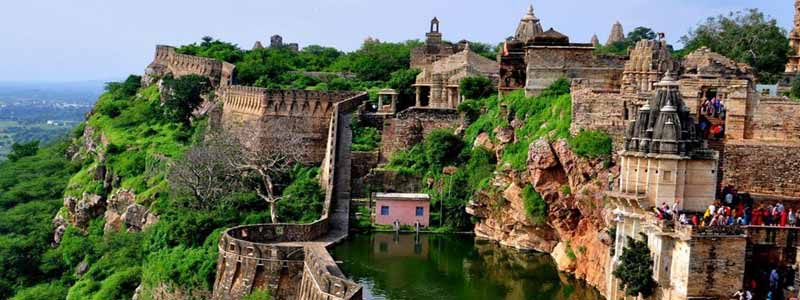
Chittorgarh Fort, Chittorgarh:
Chittorgarh Fort, situated in the city of Chittorgarh, Rajasthan, is one of the largest and most historically significant forts in India. This imposing citadel stands proudly on a hilltop, offering panoramic views of the surrounding plains. With its sprawling complex, impressive architecture, and storied past, Chittorgarh Fort is a testament to the valor, resilience, and cultural heritage of Rajasthan.
The fort’s origins date back to the 7th century, and it was later expanded and fortified by various rulers over the centuries, including the Mewar dynasty. Covering an area of over 700 acres, the fort boasts numerous palaces, temples, gates, and reservoirs within its walls.
One of the most iconic structures within the fort is the Vijay Stambha or Victory Tower, an intricately carved tower that stands tall at 37 meters. It was built by Maharana Kumbha to commemorate his victory over the combined forces of Malwa and Gujarat.
The Kirti Stambha, or Tower of Fame, is another notable structure, dedicated to the first Jain Tirthankara, Adinath. Its finely detailed sculptures and carvings make it a masterpiece of Rajput architecture.
The fort also houses several stunning palaces, including the Rana Kumbha Palace and the Padmini Palace. Each of these palaces showcases a unique blend of Rajput and Mughal architectural styles.
Chittorgarh Fort is also steeped in history, notably the siege by Alauddin Khilji in 1303, a battle that has become legendary for the Rajput’s heroic defense of their fortress. The self-sacrifice of Rani Padmini and the legendary act of Jauhar by the women of Chittorgarh further solidify the fort’s place in Rajput lore.
Today, Chittorgarh Fort stands as a UNESCO World Heritage Site and a symbol of Rajasthan’s rich cultural heritage, drawing history enthusiasts and tourists from around the world. It is a living testament to the indomitable spirit and grandeur of Rajasthan’s past.
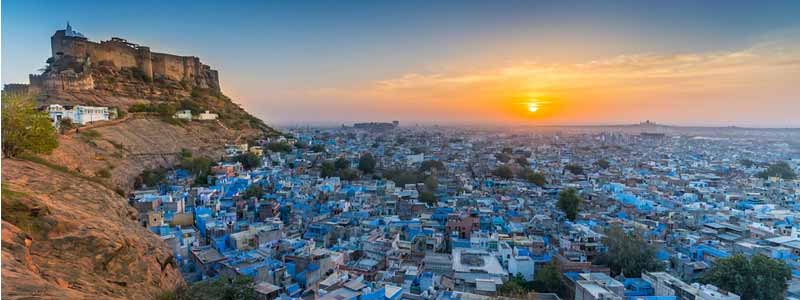
Mehrangarh Fort, Jodhpur:
Mehrangarh Fort, a formidable structure perched atop a steep hill, is an architectural masterpiece that dominates the skyline of Jodhpur, Rajasthan. This colossal fort, one of India’s largest, is a testament to the military prowess and artistic finesse of the Rajput rulers.
Built in the 15th century by Rao Jodha, the founder of Jodhpur, Mehrangarh Fort boasts imposing walls that rise over 120 feet, with several well-preserved gates leading into its sprawling complex. As you pass through the gates, you’re met with a sense of awe at the grandeur that lies within.
Within the fort’s precincts lie several palatial structures, each a marvel of Rajput architecture. Moti Mahal, adorned with delicate pearl-colored screens, was a private chamber of the Maharaja. Sheesh Mahal, or the Hall of Mirrors, is a breathtaking chamber where the walls are adorned with intricate mirror work, reflecting a thousand glittering stars.
Phool Mahal, the Palace of Flowers, exudes opulence with its elaborate gold detailing and exquisite paintings. The fort also houses a museum that displays an impressive collection of artifacts, including royal costumes, palanquins, and weaponry.
One can’t help but be captivated by the sweeping views of Jodhpur’s blue-hued old city from the fort’s ramparts. The stark contrast between the indigo buildings and the golden desert landscape is a sight to behold.
Mehrangarh Fort not only stands as a symbol of Jodhpur’s rich heritage but also serves as a living testament to the indomitable spirit of the Rajputana. It’s a place where history comes alive, narrating tales of valor, culture, and royal grandeur to all who are fortunate enough to visit.
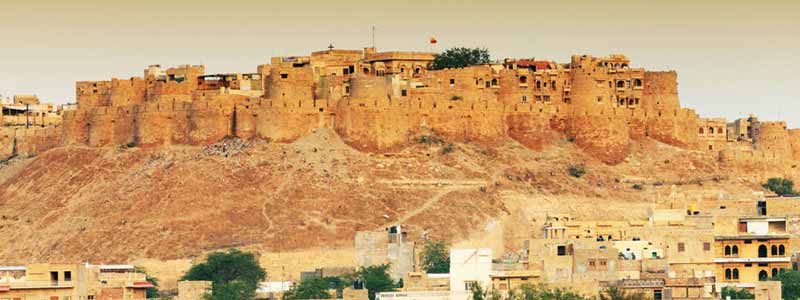
Jaisalmer Fort, Jaisalmer:
Jaisalmer Fort, located in the heart of the Thar Desert in the city of Jaisalmer, Rajasthan, is an architectural marvel that stands as a testament to the grandeur and resilience of the Rajput dynasty. This UNESCO World Heritage Site is often referred to as the “Golden Fort” due to its honey-hued sandstone walls that shimmer like gold in the desert sunlight.
Built in 1156 AD by Rawal Jaisal, the fort is one of the largest fully preserved fortified cities in the world. Its imposing walls, standing 250 feet tall, encircle the entire township and house a vibrant community within. As one steps through the intricately designed gates, a world of narrow winding alleys, ornate havelis (mansions), and stunning Jain temples opens up.
The architecture of Jaisalmer Fort is a blend of Rajput and Islamic styles, with delicate stone carvings, lattice work, and beautifully adorned balconies. The fort’s centerpiece is the Raj Mahal, a palace adorned with exquisite mirror work and frescoes, showcasing the opulence of the era.
One of the notable features of Jaisalmer Fort is its self-sufficiency. Even today, it houses a significant population, including shopkeepers, craftsmen, and families who have lived here for generations. This living fort provides a unique glimpse into the cultural heritage and daily life of its inhabitants.
From its ramparts, visitors are treated to awe-inspiring panoramic views of the city below and the undulating sands of the Thar Desert stretching out into the horizon. Sunset from the fort is a particularly mesmerizing experience, as the desert landscape is bathed in golden hues.
Jaisalmer Fort is not just a historical relic; it’s a living testament to the enduring spirit of Rajasthan and a must-visit destination for history enthusiasts and admirers of architectural splendor.
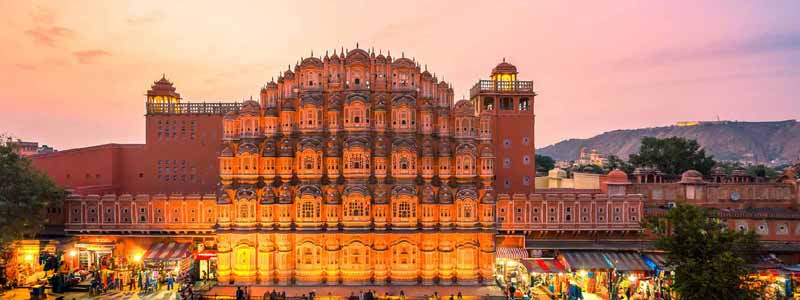
Hawa Mahal, Jaipur:
Hawa Mahal, also known as the “Palace of Winds,” is an architectural gem located in the heart of Jaipur, Rajasthan. This iconic structure is a testament to the artistic brilliance of the Rajputana era. Built in 1799 by Maharaja Sawai Pratap Singh, it stands as a quintessential example of Rajputana architecture.
The most striking feature of Hawa Mahal is its intricate facade, which is adorned with 953 small windows, or “jharokhas,” intricately designed with latticework. These jharokhas were not only ornamental but also served a practical purpose. They allowed the royal women to observe street processions and daily life in the city without being seen themselves, adhering to the strict purdah system of the time.
The structure resembles the crown of Lord Krishna, a significant deity in Hinduism, and is designed in the shape of Lord Krishna’s crown, complete with its embellishments and motifs. The palace is constructed using pink sandstone, a characteristic feature of Jaipur’s architecture, which gives it a distinct rosy hue, blending seamlessly with the rest of the Pink City.
Inside, the palace is a marvel of engineering and design. It comprises numerous chambers and passageways, each leading to different parts of the palace complex. The upper floors offer panoramic views of the bustling streets below, making it a favored spot for visitors seeking to capture the essence of Jaipur.
Hawa Mahal remains an iconic symbol of Jaipur and a must-visit destination for history enthusiasts and architectural admirers alike, serving as a vivid reminder of Rajasthan’s rich cultural heritage.
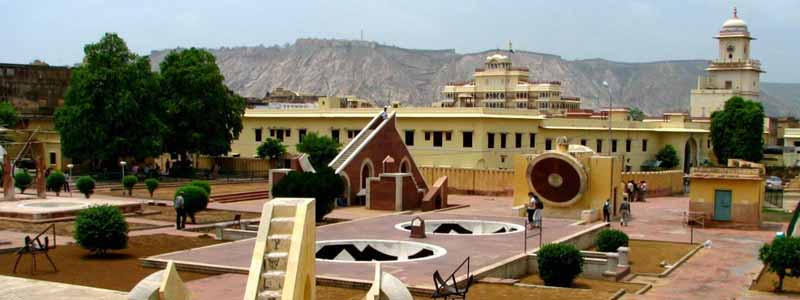
Jantar Mantar, Jaipur:
The Jantar Mantar in Jaipur, Rajasthan, is an awe-inspiring astronomical observatory that stands as a testament to the scientific prowess of ancient India. Built by Maharaja Sawai Jai Singh II in the early 18th century, this architectural marvel is one of the five Jantar Mantars constructed across North India.
Spread over a vast area, the Jantar Mantar is a collection of 19 architectural instruments meticulously designed for observing celestial phenomena and making precise astronomical measurements. These instruments were crafted using local stone and marble, with incredible precision and attention to detail.
One of the most striking features of the Jantar Mantar is the Samrat Yantra, or the “Supreme Instrument.” This massive sundial stands at a height of 27 meters and can accurately measure time to within two seconds of accuracy. Its shadow moves visibly at a rate of about one inch per minute.
The Ram Yantra, an equatorial sundial, and the Jai Prakash Yantra, a hemispherical instrument, are other notable structures within the observatory. They were ingeniously designed to track the positions of celestial bodies, including the sun, moon, and stars.
The Jantar Mantar’s architectural brilliance and its contribution to the field of astronomy have earned it a well-deserved spot on the list of UNESCO World Heritage Sites. It remains a living testament to the scientific acumen of ancient Indian astronomers and serves as a popular destination for both history enthusiasts and those fascinated by the mysteries of the cosmos.
Visiting the Jantar Mantar is a journey back in time, providing a unique glimpse into the advanced scientific knowledge and architectural finesse of the past, while also offering a deeper appreciation for the ingenuity of human intellect.
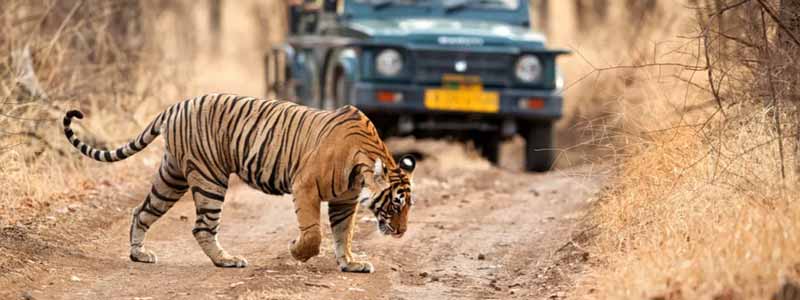
Ranthambore Fort, Sawai Madhopur:
The Ranthambore Fort, situated in Sawai Madhopur, Rajasthan, is a magnificent historical edifice that blends seamlessly with the rugged landscape of the Ranthambore National Park. This fort, which spans over 7 kilometers in circumference, stands as a testament to the rich history of Rajasthan and its royal heritage.
The fort’s history is believed to date back to the 10th century when it was built by the Chauhan Rajput king, Sapaldaksha. Over the centuries, it passed through the hands of various rulers, including the Mughals and the Maharajas of Jaipur. Its strategic location atop a hill made it an impregnable stronghold.
One of the most iconic features of the Ranthambore Fort is the Trinetra Ganesh Temple, dedicated to Lord Ganesha. The temple’s unique three-eyed idol of Ganesha is a revered deity and attracts devotees from far and wide Top 10 Famous Historical Places in Rajasthan.
Apart from its religious significance, the fort is a treasure trove of historical and architectural wonders. It boasts massive gates, impressive walls, and several palaces, including the Hammir Court, which offers panoramic views of the surrounding landscape.
The Ranthambore Fort is not only a historical gem but also a UNESCO World Heritage Site. Its location within the Ranthambore National Park allows visitors to combine their love for wildlife with history, making it a unique destination for nature enthusiasts and history buffs alike.
As you explore the Ranthambore Fort, you’ll be transported back in time, and you’ll gain a deeper appreciation for the cultural and historical richness of Rajasthan. It is a must-visit destination that provides a captivating blend of history, spirituality, and natural beauty.
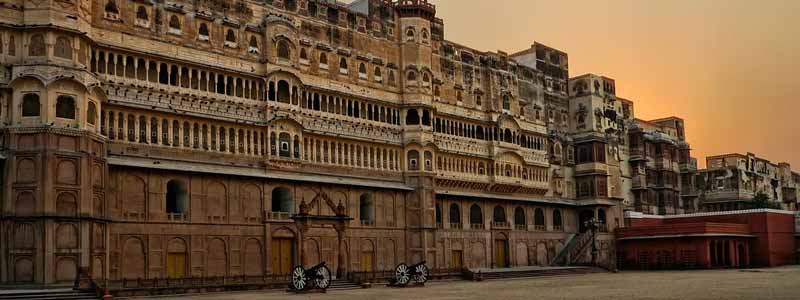
Junagarh Fort, Bikaner:
Junagarh Fort, located in the heart of Bikaner, Rajasthan, stands as a testament to the architectural brilliance and military prowess of the Rajputs. Constructed in the 16th century by Raja Rai Singh, a trusted general of Emperor Akbar, this fort is one of the few in Rajasthan that wasn’t built on a hill.
The fort’s formidable walls, constructed with red sandstone and marble, are adorned with intricate carvings and ornate balconies. The architectural style is a harmonious blend of Rajput, Mughal, and Gujarati influences, reflecting the cultural amalgamation of the era.
Within the fort, you’ll find a series of beautifully decorated palaces, courtyards, and temples. The Phool Mahal (Flower Palace) is a striking example of the opulence of the Rajput rulers, with its gold leaf decorations and exquisite mirror work. The Anup Mahal, Karan Mahal, and Chandra Mahal are equally impressive, showcasing an array of artistic elements.
The fort also houses a museum that exhibits a diverse collection of artifacts, including weapons, paintings, textiles, and even royal costumes. These relics provide a fascinating insight into the rich history and lifestyle of the Rajput rulers Top 10 Famous Historical Places in Rajasthan.
One of the unique features of Junagarh Fort is the presence of multiple entrances, each built to commemorate a significant military victory. The Suraj Pol, Chand Pol, and Karan Pol are among the grand gateways that lead into the fort.
Visiting Junagarh Fort is like stepping into a living museum, where the walls echo with tales of valor and grandeur. Its impeccable architecture and historical significance make it a must-visit destination for anyone exploring the cultural heritage of Rajasthan.
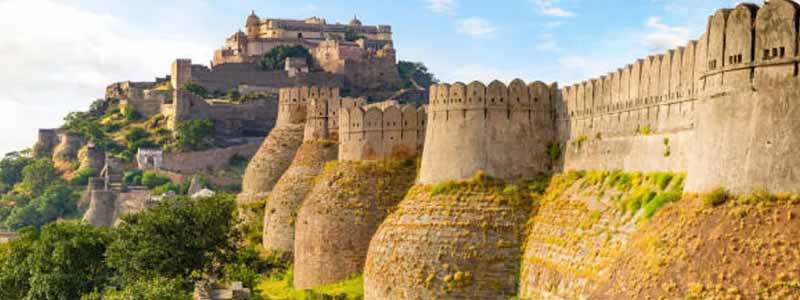
Kumbhalgarh Fort, Rajsamand:
Kumbhalgarh Fort, located in Rajsamand district of Rajasthan, India, is a testament to the architectural brilliance and strategic acumen of the Rajputana era. It stands proudly atop the Aravalli Hills, approximately 1,100 meters above sea level, making it one of the highest forts in Rajasthan.
Built in the 15th century by Rana Kumbha, a ruler of the Mewar Kingdom, the fort stretches over 38 kilometers in circumference, making it one of the longest wall complexes in the world, second only to the Great Wall of China. The walls of Kumbhalgarh are not only impressively long but also incredibly thick, wide enough for eight horses to march abreast.
The fort is known for its seven grand gates, each intricately designed and fortified. The most renowned of these is the Hanuman Pol, with a temple dedicated to Lord Hanuman just outside. The Badal Mahal, or the Palace of Clouds, is another highlight, offering breathtaking panoramic views of the surrounding countryside.
Kumbhalgarh also boasts over 360 temples within its precincts, including the Mammadev Temple, Neelkanth Mahadev Temple, and Vedi Temple. The most celebrated among them is the Kumbha Palace, an amalgamation of Hindu and Mughal architectural styles.
Apart from its architectural splendor, Kumbhalgarh holds historical significance as the birthplace of the legendary Rajput warrior, Maharana Pratap. The fort also played a pivotal role in the history of Mewar, serving as a sanctuary during times of conflict Top 10 Famous Historical Places in Rajasthan.
Today, Kumbhalgarh Fort is a UNESCO World Heritage Site, attracting tourists, history enthusiasts, and architecture aficionados from around the world. Its imposing walls, exquisite palaces, and ancient temples make it a must-visit destination for those seeking a glimpse into Rajasthan’s rich heritage.

